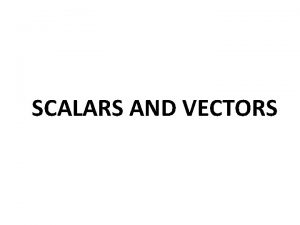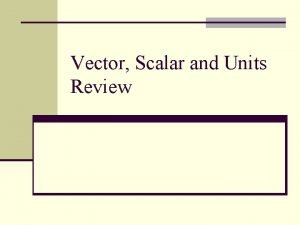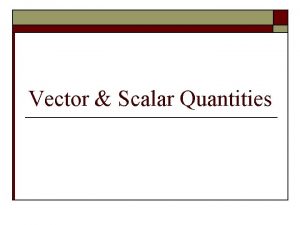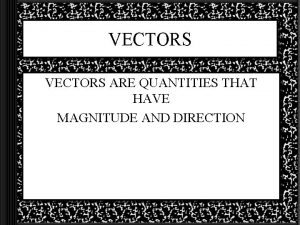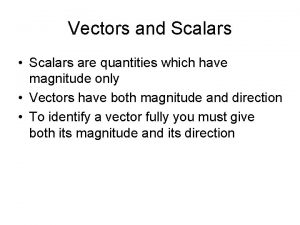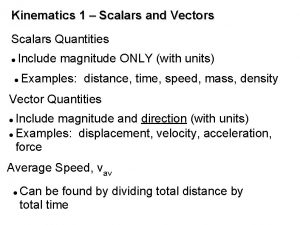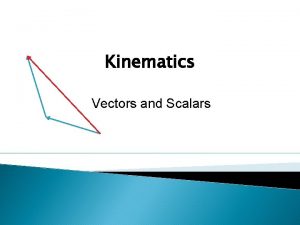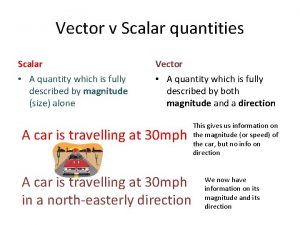Vectors and Scalars Vector and Scalar Quantities Scalar














- Slides: 14

Vectors and Scalars

Vector and Scalar Quantities Scalar quantities have magnitude only. Vector quantities have magnitude and direction. Note: By definition, all base quantities have no direction and so are scalar. Vectors Displacement Velocity Weight Scalars Distance Speed Mass Acceleration Force Time Energy

Vector Arrows A Vector is often represented using a straight arrow. The length of the arrow represents its magnitude, it’s direction represents the direction of the vector. E. g. A Force of 15 N at an angle 30° to the horizontal 15 N 30° It can have a vertical… = 15 sin 30 = … and horizontal component = 15 cos 30 =

Vector Addition Vectors can be added using a graphical method or by adding perpendicular components. Graphical method (Link)

Example R=a+b a + b =

Example R=a+b a + b =

Example a - b = R = a + (- b) -b

Vector addition using components Any vector can be resolved into two perpendicular components. Often these may be horizontal and vertical. If more than one vector are being added together, the parallel components may be added. E. g. Two forces act on a body as shown. What is the resultant force? 40 N For the 40 N force: Vertical component = 40 sin 60 = 34. 6 N Horizontal component = 40 cos 60 = 20. 0 N 60° 30° 50 N For the 50 N force: Vertical component = 50 sin 30 = (-) 25. 0 N Horizontal component = 50 cos 30 = 43. 3 N

E. g. Two forces act on a body as shown. What is the resultant force? 40 N For the 40 N force: Vertical component = 40 sin 60 = 34. 6 N Horizontal component = 40 cos 60 = 20. 0 N 60° 30° 50 N For the 50 N force: Vertical component = 50 sin 30 = 25. 0 N Horizontal component = 50 cos 30 = 43. 3 N Resultant: Vertical force = 34. 6 - 25. 0 = 19. 6 N Horizontal component = 20. 0 + 43. 3 = 63. 3 N 19. 6 N 63. 3 N Calculate resultant using pythagoras… Resultant force = √ (19. 62 + 63. 32) = 66. 2 N … Now calculate the angle from the horizontal

Subtitle Text

Subtitle Text

Subtitle Text

Subtitle Text

Subtitle Text
 A storm system moves 5000 km due east
A storm system moves 5000 km due east Difference between vector and scalar
Difference between vector and scalar Vector and scalar quantities
Vector and scalar quantities Entropy is scalar or vector
Entropy is scalar or vector Lesson plan on vectors and scalars
Lesson plan on vectors and scalars Multiplying or dividing vectors by scalars results in
Multiplying or dividing vectors by scalars results in Vector vs scalar
Vector vs scalar Scalar quantity and vector quantity
Scalar quantity and vector quantity Does a scalar have magnitude
Does a scalar have magnitude 50 examples of scalar and vector quantities
50 examples of scalar and vector quantities Vector versus scalar
Vector versus scalar Linear acceleration and angular acceleration
Linear acceleration and angular acceleration Vectors are quantities that have magnitude and
Vectors are quantities that have magnitude and Physical quantities of vectors
Physical quantities of vectors Chapter 1 physical quantities and measurement
Chapter 1 physical quantities and measurement



